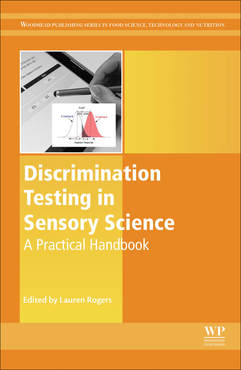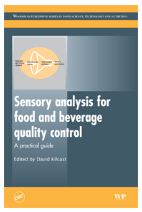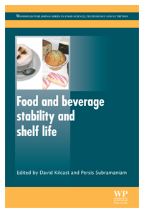Welcome
- Lauren Rogers
- Publications
- Affiliations
- Sensory Science Courses
- Contact Details
- Experience
- Achievements
- Artificial Intelligence Links
- Pangborn International Sensory Science Conference
- LINKS
- IFST SSG
- Why is sensory science so important?
- Contact Form
- Jobs
Discrimination Testing in Sensory Science: A Practical Handbook

Discrimination Testing in Sensory Science: A Practical Handbook is a one-stop-shop for practical advice and guidance on the performance and analysis of discrimination testing in sensory science. The book covers all aspects of difference testing: the history and origin of different methods, the practicalities of setting up a difference test, replications, the statistics behind each test, dealing with the analysis, action standards, and the statistical analysis of results with R.
More information here
More information here
Sensory Panel Management: A Practical Handbook for Recruitment, Training and Performance

Covering all aspects of sensory panel management, this volume describes the different types of sensory panels (for example panels for quality control, descriptive analysis and discrimination tests), discusses the issues involved with sensory testing, and gives detailed information about sensory panel recruitment, training and on-going management.
Sensory Panel Management gives both theoretical and practical information from deciding what type of panel to recruit and how to conduct panel training, to creating the best sensory team and how to deal with any issues. Downloads of several of the documents included in the book are available from http://www.laurenlrogers.com/sensory-panel-management.html
The book is divided into three main sections. The first section looks at the recruitment of sensory panels, covering the process from both a scientific and a human resources angle. The second section deals with the training of a sensory panel. Initial training, as well as method and product specific training is covered. Example session plans for running panel sessions for quality control, discrimination tests, descriptive profiling, temporal methods and consumer tests are included within the specific chapters. Refresher and advanced training such as training panelists to take part in gas chromatography-olfactometry are also included. The third section examines the performance of sensory panels. Chapters within this section explore performance measures and ways of preventing (and dealing with) difficult situations relating to panellists. A final chapter looks at the future of sensory panels. Throughout the book there are short case study examples demonstrating the practical application of the methods being discussed.
Sensory Panel Management is a key reference for academics, technical and sensory staff in food companies - more information here
Sensory Panel Management gives both theoretical and practical information from deciding what type of panel to recruit and how to conduct panel training, to creating the best sensory team and how to deal with any issues. Downloads of several of the documents included in the book are available from http://www.laurenlrogers.com/sensory-panel-management.html
The book is divided into three main sections. The first section looks at the recruitment of sensory panels, covering the process from both a scientific and a human resources angle. The second section deals with the training of a sensory panel. Initial training, as well as method and product specific training is covered. Example session plans for running panel sessions for quality control, discrimination tests, descriptive profiling, temporal methods and consumer tests are included within the specific chapters. Refresher and advanced training such as training panelists to take part in gas chromatography-olfactometry are also included. The third section examines the performance of sensory panels. Chapters within this section explore performance measures and ways of preventing (and dealing with) difficult situations relating to panellists. A final chapter looks at the future of sensory panels. Throughout the book there are short case study examples demonstrating the practical application of the methods being discussed.
Sensory Panel Management is a key reference for academics, technical and sensory staff in food companies - more information here
Food and beverage stability and shelf life
_http://www.woodheadpublishing.com/en/book.aspx?bookID=1900
Chapter 20: Practical uses of sensory evaluation for the assessment of soft drink shelf life L L Rogers, Consultant, UK - Introduction - Using a risk based approach to shelf life for soft drinks - Estimating shelf life - Determining shelf life - Monitoring shelf life - Considerations before developing the shelf life plan - Developing the sensory plan - Case studies - Future trends - References and sources of further information and advice |
Sensory analysis for food and beverage quality control

http://www.woodheadpublishing.com/en/book.aspx?bookID=1519
Edited by D Kilcast, Consultant, Food and Beverage Sensory Quality, UK
Woodhead Publishing Series in Food Science, Technology and Nutrition No. 191
In my opinion this book fills a serious hole in commercial sensory literature. This is a comprehensive text on a crucial topic. I will certainly be using it in my courses.
Dr Hal MacFie, Hal MacFie Training Services, UK
The book more than lives up to its subtitle, in that it provides practitioners in the food industry with the necessary background to establish and maintain a sensory quality control system.
Lebensmitteltechnik
I found this document to certainly be one of the best, if not the best to date.
Food and Beverage Reporter
Edited by D Kilcast, Consultant, Food and Beverage Sensory Quality, UK
Woodhead Publishing Series in Food Science, Technology and Nutrition No. 191
In my opinion this book fills a serious hole in commercial sensory literature. This is a comprehensive text on a crucial topic. I will certainly be using it in my courses.
Dr Hal MacFie, Hal MacFie Training Services, UK
The book more than lives up to its subtitle, in that it provides practitioners in the food industry with the necessary background to establish and maintain a sensory quality control system.
Lebensmitteltechnik
I found this document to certainly be one of the best, if not the best to date.
Food and Beverage Reporter
_Using sensory techniques for shelf-life assessment
L L Rogers, Consultant, UK
- Introduction
- What is shelf-life? Setting or confirming shelf-life?
- The case study: Setting up shelf-life confirmation studies for an ambient product
- References and further reading
L L Rogers, Consultant, UK
- Introduction
- What is shelf-life? Setting or confirming shelf-life?
- The case study: Setting up shelf-life confirmation studies for an ambient product
- References and further reading
_Sensory methods for quality control
L L Rogers, Consultant, UK
- Introduction
- Descriptive specifications method (DS)
- ‘In/out’ (or pass/fail) method
- Difference from control (DFC) method
- 'A' not 'A' method
- Paired comparison methods (e.g
- 2AFC, n-AFC, simple difference test)
- Scaling method (including targeted scaling)
- Ranking test
- Triangle test
- Quality scoring/grading/rating method
- Magnitude estimation and duo-trio methods
- In-house and do-it-yourself (DIY) methods
- References
L L Rogers, Consultant, UK
- Introduction
- Descriptive specifications method (DS)
- ‘In/out’ (or pass/fail) method
- Difference from control (DFC) method
- 'A' not 'A' method
- Paired comparison methods (e.g
- 2AFC, n-AFC, simple difference test)
- Scaling method (including targeted scaling)
- Ranking test
- Triangle test
- Quality scoring/grading/rating method
- Magnitude estimation and duo-trio methods
- In-house and do-it-yourself (DIY) methods
- References
Main Pages
|
Other Pages
|
Lauren Rogers
|
